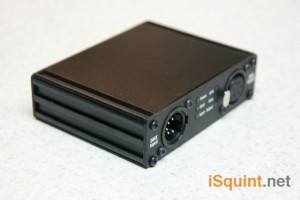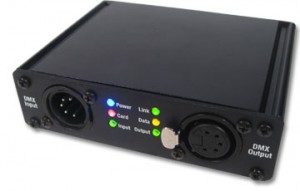Review: Interactive Technologies CueServer Express
 The different styles of lighting control available to us are staggering. It seems as though each manufacturer puts a twist on how we can manipulate lumens, as well as “barrow” things from each. One company that has separated themselves from the pack is Interactive Technologies. While most manufacturers offer a hardware interface to select and manipulate lights, Interactive Technologies gives you a webpage.
The different styles of lighting control available to us are staggering. It seems as though each manufacturer puts a twist on how we can manipulate lumens, as well as “barrow” things from each. One company that has separated themselves from the pack is Interactive Technologies. While most manufacturers offer a hardware interface to select and manipulate lights, Interactive Technologies gives you a webpage.
Let me explain, at the heart of Interactive Technologies control offerings is the CueServer, a website-in-a-box that offers control from either a webpage or a button station like the SceneStation available from Interactive Technologies and outputs DMX control.
At LDI2010 I was introduced to the Interactive Technologies latest product, the CueServer Express. This has to be the smallest website and DMX controller out there. Don’t let the size and simple exterior fool you, there is some serious control in the CueServer Express.
The CueServer Express is the little brother to Interactive Technologies CueServer Pro and CueServer Mini control products. It is considered an entry level control device for portable applications and cost effective. Just like all the CueServer products, the CueServer express includes a built-in web server that provides access to a full complement of lighting controls, show programming and playback features without the need for special software or an Internet connection.
The power behind the CueServer Express lies hidden within this tiny little box of just 5″ wide, 3.5″ long and just 1″ high. It looks simple, but again, looks can be deceiving. After connecting the CueServer Express to my local network, and plugging in a DMX line to some devices, it was up and running. The CueServer Express was assigned an IP through my DHCP server, after finding what that IP was by simply pinging the network, I just had to goto the IP address via my browser and I was in.
What is happening behind the scenes and in the network is that you are communicating directly with the CueServer Express via it’s web server function. You are sending commands and instructions over the network by TCP/IP to the CueServer Express. Then within the CueServer Express, those instructions are translated and sent out the single DMX line to our devices. The CueServer isn’t spending and receiving Art-Net, but standard web page instructions.
[singlepic id=1518 w=320 h=240 float=left]The beauty and simplicity of this design is the interface. The default web page control out of the CueServer Express is fairly basic. No frills and images to download, but a very basic and some what powerful control surface.
What caught my attention is “CueScript”, a programing language for the CueServer family. Think of it as the command line for the CueServer Express, very similar to most lighting controllers have. Rather then using the built in keypad on the web page, you can enter commands via the command line or CueScript. The beauty part about CueScript is that you do not have to type out entire words, for instance, for channel, rather then typing out the entire word, just type c and then the number @ fl, ie: c1@fl. Their is a help box below the command line that spells out what you have typed in plain English to assume you that you have typed in the command that you want. The commands can be as long and complicated as you want them to be.
From the web page, you have the ability to use the built in keypad which is very similar to most lighting desk out there with a number pad, record and timing functions. But wait, theirs more. In addition to the number pad, you have three other keypad pages. The second being a recall section for colors, just like pallets that you find on many other desk. The last two pages are all yours, you can edit and record any command you like to 25 buttons per page.
Say command line isn’t your cup of tea, no worries, Interactive Technologies isn’t holding you back. You have a number of other alternatives to send commands to the CueServer Express, such as the Brand New Figment iOS App, CuePad iOS app, custom Flash Applications and Interactive Technologies own button and touch screen station options.
For this review, I only had a chance to connect the Figment iOS app to the CueServer Express. While I was temped to try some custom Flash interfaces, it really didn’t pertain to the review. As for the Figment App, so simple and easy. Connecting the Figment App to the CueServer Express was just as simple as setting up the CueServer Express. You just have to make sure the wireless access point that the iOS devices connects to is on the same network and subnet. From there, the Figment finds any available CueServers and away you go.
The CueServer Express offers 512 channels on control, or a entire universe minus the ability to patch. So patch is always 1-to1. Another thing lacking out of the CueServer Express is the ability to patch multi-parted devices or fixtures that use more then one channel of control. Is this a limitation? Not when you look at when and where the CueServer is intended for.
The CueServer Express is marketed as a portable lighting solution and for architectural control. I think the later is where the CueServer Express excels at. Digging deeper into the controls and options on the CueServer Express, you’ll find the ability to write to four different cue list, each with independent timing and control. On top of that are controls for triggers such as function buttons, contact closures, macros, timer list and most importantly, timecode events.
With timecode in an architectural installation, you don’t need an input or button station. Record your looks and have them run at specific times of the day. Creating and setup looks to go at a certain time during the day is super simple. During my time with the CueServer Express, I quickly and easily created a time event that happened every day at the same time before I came home. So I came home to nice soothing orange uplight in the office, ah, soothing orange.
I enjoyed my time with the CueServer Express. It was easy to setup, get up and running and begin to control some lights. While the controls and functions are super simple, it may not the best option for a rig with mass amounts of movers. But in an architectural installation or a simmer heavy rig, the CueServer Express packs some pretty powerful features in a box the size of a roll of two inch gaff.
If you want to try the CueServer out, or at least try the web page functions, head over to interactive Technologies web site, www.interactive-online.com.
[nggallery id=97]
Interactive Technologies Announces Figment DMX for iOS & CueServer Express
 I have always had a fascination for Interactive Technologies products, especially their CueServer. Rather then developing a traditional lighting desk, they built a rack “desk” that you access via http or web page. While the CueServer “desk” is not marketed as a live playback desk, but as an architectural and themed environment control. How cool is that! You can customize your “control surface” all just by designing a web page.
I have always had a fascination for Interactive Technologies products, especially their CueServer. Rather then developing a traditional lighting desk, they built a rack “desk” that you access via http or web page. While the CueServer “desk” is not marketed as a live playback desk, but as an architectural and themed environment control. How cool is that! You can customize your “control surface” all just by designing a web page.
Interactive Technologies has stepped it up a bit and developed & launched their Figment DMX iOS app. The ultimate remote focus, show control and programming app for CueServer. Designed for lighting designers, technicians and riggers, Figment is a powerful application for wirelessly controlling multiple universes of DMX lighting via the popular family of CueServer DMX interfaces.
Figment requires any one of five different models of CueServer DMX interface and a WiFi wireless network or 3G connection via a publicly accessible IP address. Figment will also run without a CueServer interface for exploring the software.
You can learn more about the Figment DMX App on Interactive Technologies website as well as download your FREE copy of the app from the iTunes App Store.
[nggallery id=71]
CueServer Express
 Along with the Figment DMX App, Interactive Technology announced the arrival of the CueServer Express. If you are a MacAddict like me, think of the CueServer Express and the Airport Express of the CueServer lineup. Portable, easy setup and fully featured as the CueServer but optimized for use with the Figment DMX app and other cost-sensitive control projects.
Along with the Figment DMX App, Interactive Technology announced the arrival of the CueServer Express. If you are a MacAddict like me, think of the CueServer Express and the Airport Express of the CueServer lineup. Portable, easy setup and fully featured as the CueServer but optimized for use with the Figment DMX app and other cost-sensitive control projects.
CueServer is a complete lighting playback and integration processor, featuring advanced DMX lighting control, sophisticated event scripting and robust I/O capabilities combined in a tiny web-based device. Great for both architectural and entertainment lighting control projects, CueServer provides an unprecedented level of control and customization in an easy-to-use package.
To learn more about the CueServer Express, visit Interactive Technologies website, www.interactive-online.com.
If you are heading out to Las Vegas next week for LDI, make sure to stop by Interactive Technologies stand, #1967 and see the Figment DMX app, CueServer Express and all of their other products in action.
LatestHeadlines
- Upgrading Your Toolbox: City Theatrical DMXcat-E and DMXcat Multi Function Test Tool
- Claypaky Bringing Back the Sexy to Par Cans with the Midi-B FX
- Ayrton Evolves the Cobra, the Cobra2 Developed for the US Market
- MA Lighting Intros grandMA3 onPC Fader Wing and DIN-Rail Nodes
- Live Events LEVL Up Fest: A Festival to Aid our Industry